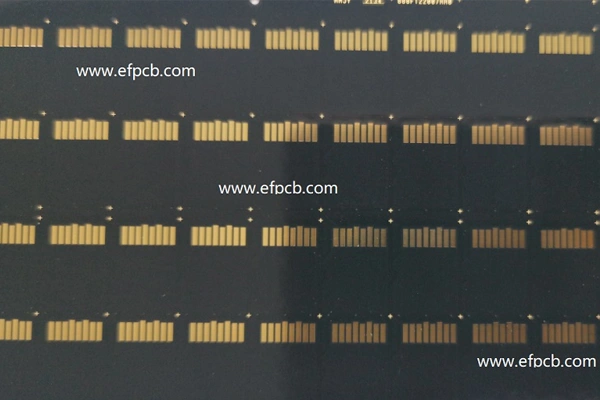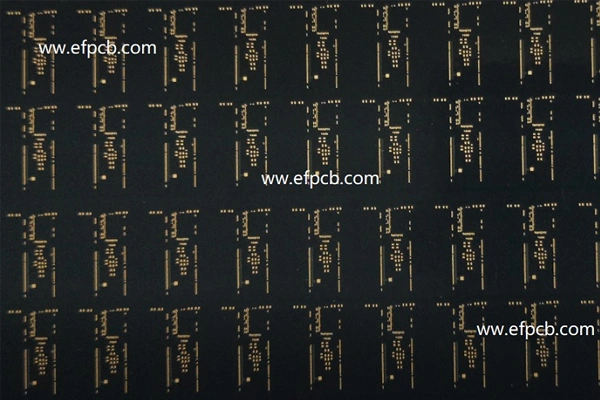-
Mail Us Todaysales@efpcb.com
-
Company LocationShenzhen, Guangdong, China
-
+86-755-23724206Call us for more details



Part No. : E0236060119A
Substrate thickness : 0.21+/-0.03mm
Layer count : 2 layer
Core Material : AMC832-HF
Solder Mask : EG23
Minimum trace : 30 um
Minimum space(gap): 25 um
Minimum hole: 0.10 mm
Surface finished: Soft gold + Hard gold
Unit size: 11*15mm
Tenting, via 0.10mm, BT material, hard gold and solft gold.
Do you get annoyed by low-performance and untrustworthy memory cards? Picture this: it is that one memorable holiday when you are taking pictures of breathtaking views as seen through your lens. However, all of a sudden, your memory card spoils you, and you cannot capture such meaningful moments anymore. Do not allow this to happen to you. The world of IC Substrates for Transflash Cards - the best way to avoid information loss and ensure high quality work.
This extensive guide will deal with every concern you might have about making tented tapes on IC substrates of different materials such as 0.10 mm, BT, Hard Gold, and even Soft Gold. We know how irritating can be to lose critical information or to have a slow transfer speed, for this reason, let us show what and to avoid when selecting a network.
So if you are willing to say good bye to memory card mess ups and hello to reliable and fast performance storage, dive into it with us while we explore the intricate process of IC Substrate for Transflash Cards. Your memories deserve nothing but the best. And this is our duty; they shall always remain sharp.
This guide will focus on the technicalities behind the ic substrate in transflash cards and why you should care about it. We will elucidate the idea of tenting, and why it provides protection against external items that may also cause damage.
There are different types of IC substrates, and we will take you through the rigors of selecting the optimal ones suitable for your purpose. In this regard, we can take into consideration the pros of via (0.10 mm), the pros of BT substances, and the pros of both difficult gold and sensitive gold IC substrates so that you will better know which is suitable for you.
But it doesn't end there. From personal experience, we have had to deal with slow file transfer speeds as well as data loss anxiety. Therefore, we’ll give useful information on how to make the best out of your transflash card to ensure that each press of the shutter or video recording is successfully captured in the system for quick retrieval.
Let's go through this voyage together and discover the intriguing landscape of IC substrates for transflash cards. When you finish reading through this guide, you will understand what separates these cards from each other and will know which one fits your particular needs.
Micro SD Card, formerly known as Trans-flash Card (TF card), was officially renamed Micro SD Card in 2004. It was invented by SanDisk and is mainly used for mobile phones.
Before the launch of Micro SD, mobile phone manufacturers used embedded memory. Although this type of module is easy to install, it has the problem that it can not meet the actual demand of the trend - the capacity is limited and there is no room for upgrading. Micro SD emulates the application mode of SIM card, that is, the same card can be used in different models of mobile phones, so that mobile phone manufacturers no longer have to worry about plug-in R&D and design. Micro SD card can be regarded as a removable storage IC.
Micro SD card is a very small flash memory card. Its format is created by SanDisk. This memory card was originally called T-Flash, and later called Trans Flash; The reason why it was renamed Micro SD was that it was adopted by the SD Association (SDA). Other memory cards adopted by SDA include Mini SD and SD cards. It is mainly used in mobile phones, but because of its small size and continuous improvement of storage capacity, it has been used in GPS devices, portable music players and some flash memory disks. Its volume is 15mm x 11mm x 1mm, almost equal to the size of a fingernail, and it is the smallest memory card at present. It can also be connected to the SD card slot through the SD adapter card. At present, Micro SD cards offer capacities of 128MB, 256MB, 512MB, 1G, 2G, 4G, 8G, 16G, 32G, 64G and 128G (During the MWC 2014 World Mobile Communication Conference, SanDisk (Sandi) broke the tradition of memory cards with a maximum capacity of 64GB and officially released a Micro SD XC memory card with a capacity of up to 128GB.